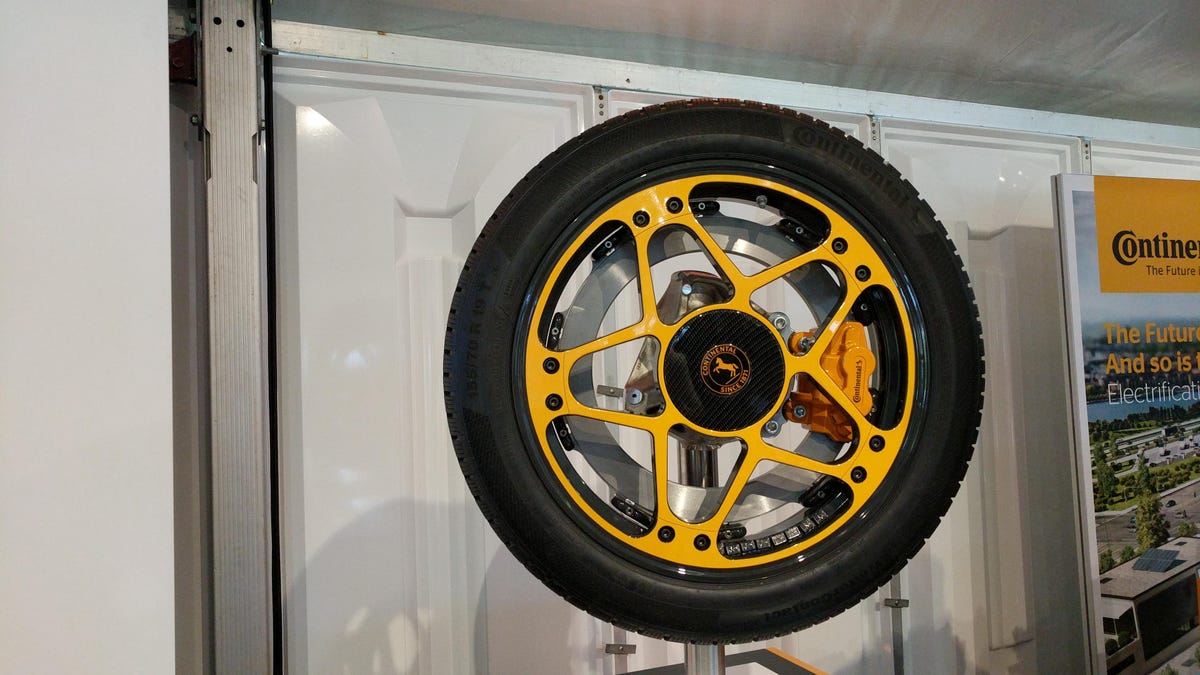Future EVs may tread lighter, brake better wearing these concept wheels
Taller, narrower and, most importantly, lighter. Continental's 'New Wheel Concept' is actually all about the brakes.

Sure, it's got an uninspired name, but Continental's 'New Wheel Concept' is an interesting and realistic take how a few small changes in today's wheel design could net improvements in the range and performance of electric vehicles in the future.
The first step is to reduce rolling resistance which can add a few extra miles to an EV's range by making coasting and cruising more energy efficient. The concept does that by increasing the tire radius while narrowing the tread width. This reshapes and stretches the contact patch (literally, where the rubber meets the road) reducing resistance and friction when rolling in a straight line without compromising grip for cornering. The BMW's i3's oddly narrow wheels already apply this principle and Continental's New Wheel Concept uses an identical P155/70R19 sized tire as its base.
But that's technology that we can already see in action on the road today. Continental's New Wheel Concept doesn't reinvent the wheel; it re-imagines the brakes. I spoke with Paul Linhoff, Head of Chassis & Brake Systems & Functions and Advanced Engineering at Continental and he explained how the New Wheel Concept aims to improve beyond just tall and skinny.
The taller wheels, according to Linhoff, generate more torque when when spinning because of their larger radius gives them more leverage. So stopping those taller than average wheels requires bigger and heavier brakes than normal to counteract the increased rotational force. And more weight means less efficiency and worse performance; it's a lose-lose.
Continental hopes to solve this problem by increasing the radius of the brake rotor. Now instead of being a relatively small, solid disk that sits on the wheel's hub, the rotor is a large hoop that's just a bit smaller than the wheel's rim. This change increases the braking torque available to the inverted, lightweight caliper (which now sits inside the rotor hoop) to match that of the larger tire radius while keeping parts weight low.
The concept wheel uses a large, aluminum hoop in place of a rotor disc and a small, inverted caliper to improve stopping power while also reducing weight.
The New Wheel Concept's further reduces weight by making that rotor hoop of a lightweight, heat resistant aluminium alloy, so the overall braking system weight is lower than before. A positive side effect is that this larger rotor is able to dissipate heat more effectively than traditional steel disk rotors due to aluminium's lower specific heat and the increased surface area, which should result in less fade and wear.
The wheel itself is a two-piece design. The outer rim removes from the spokes and brakes with a few bolts for easy tire changes and servicing.
All in, the New Wheel Concept claims to weigh less overall and roll with less friction than a traditional tire without compromising braking performance or cornering grip when compared to more conventional wheel and brake packages. Plus, it looks pretty freaking sweet.
I couldn't help but ask about potential performance applications for the New Wheel Concept's brake setup, but Continental's representatives just grinned and restated that point is efficiency and economy for EV applications. The tire manufacturer and parts supplier will be showcasing the wheel concept and other technologies later this year at the Frankfurt motor show.
Editor's note: Roadshow accepts multi-day vehicle loans from manufacturers in order to provide scored editorial reviews. All scored vehicle reviews are completed on our turf and on our terms. However, for this feature, travel costs were covered by the manufacturer. This is common in the auto industry, as it's far more economical to ship journalists to cars than to ship cars to journalists. The judgments and opinions of Roadshow's editorial team are our own and we do not accept paid editorial content.

